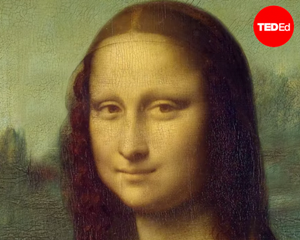As dawn broke over Paris on August 21st, 1911, Vincenzo Peruggia hoisted a painting off the wall and slipped down the back stairs of the Louvre.
1911年8月21日,当巴黎的黎明破晓之时,文森佐·佩鲁贾从墙上取下一幅画,接着从卢浮宫的后楼梯溜走。
He was close to freedom, the exit just before him when he encountered a two-pronged problem: the door was locked and footsteps were approaching.
他即将走向自由,出口就在他面前,这时他遇到了两个问题:门是锁着的,脚步声正在靠近。
Tucked under Peruggia's arm was Leonardo da Vinci's "Mona Lisa."
佩鲁贾的胳膊下夹着列奥纳多·达·芬奇的《蒙娜丽莎》。
It's arguably the world's most famous painting today. But how did it achieve its status?
它可以说是当今世界上最著名的画作。但它是如何获得这样的地位的呢?
Leonardo is thought to have started the portrait in 1503 at the request of a Florentine businessman who wanted a portrait of his wife, Lisa Gherardini.
据推测,达芬奇于1503年应一位佛罗伦萨商人的要求而开始创作这幅肖像画,这位商人想要一幅他的妻子丽莎·盖拉尔迪尼的肖像。
Leonardo continued working on the painting for more than 10 years, but it was unfinished by the time he died.
达·芬奇在这幅画上持续创作了10多年,但在他去世时这幅画尚未完成。
Over his lifetime, Leonardo conducted groundbreaking studies on human optics, which led him to pioneer certain artistic techniques.
在他的一生中,列奥纳多对人类光学进行了开创性的研究,这使他成为某些艺术技巧的先驱。
Some can be seen in the "Mona Lisa." Using "atmospheric perspective," he made images at greater distances hazier, producing the illusion of profound depth.
有些可以在《蒙娜丽莎》中看到。利用“空气透视”,他使距离更远的图像变得朦胧,产生一种深邃的错觉。
And with "sfumato," he created subtle gradations between colors that softened the edges of the forms he depicted.
通过“晕涂法”,他在颜色之间创造了微妙的渐变软化了他所描绘的形式的边缘。
All of this is striking, but is it enough to make the "Mona Lisa" the world's most famous painting?
所有这些都令人震惊,但这足以使《蒙娜丽莎》成为世界上最著名的画作吗?
Many scholars consider it an outstanding Renaissance portrait -- but one among plenty.
许多学者认为这是一幅杰出的文艺复兴时期的肖像画,但这只是其中之一。
And history is full of great paintings. Indeed, the "Mona Lisa's" rise to worldwide fame depended largely on factors beyond the canvas.
历史上不乏伟大的画作。事实上,《蒙娜丽莎》之所以能在全世界声名鹊起,在很大程度上取决于画布以外的因素。
King Francois the First of France purchased the painting and began displaying it after Leonardo's death.
法国国王弗朗索瓦一世购买了这幅画,并在莱昂纳多去世后开始展出。
Then, in 1550, Italian scholar Giorgio Vasari published a popular biography of Italian Renaissance artists, Leonardo included.
然后,在1550年,意大利学者乔尔乔·瓦萨里出版了一本受欢迎的意大利文艺复兴时期艺术家传记,其中包括莱昂纳多。
The book was translated and distributed widely, and it contained a gushing description of the "Mona Lisa" as a hypnotic imitation of life.
这本书被翻译并广泛传播,其中包含了对《蒙娜丽莎》的描述溢于言表,说它是对生活的一种催眠般的模仿。
Over the years, the "Mona Lisa" became one of the most enviable pieces in the French Royal Collection.
多年来,“蒙娜丽莎“成为法国皇家收藏中最令人羡慕的作品之一。
It hung in Napoleon's bedroom and eventually went on public display in the Louvre Museum.
它挂在拿破仑的卧室里,并最终在卢浮宫博物馆公开展出。
There, visitors flocked to see the once-private treasures of the deposed aristocracy.
在那里,游客蜂拥而至去看被废黜的贵族曾经的私人宝藏。
During the 1800s, a series of European scholars further hyped the "Mona Lisa" up, fixating to a conspicuous degree on the subject's allure.
在19世纪,一系列的欧洲学者进一步炒作《蒙娜丽莎》,将注意力集中在主题的吸引力上。

In 1854, Alfred Dumesnil said that Mona Lisa's smile imparted a "treacherous attraction."
1854年,阿尔弗雷德·杜梅尼尔说,蒙娜丽莎的微笑传递了一种“危险的吸引力”。
A year later, Théophile Gautier wrote of her "mocking lips" and "gaze promising unknown pleasures."
一年后,泰奥菲勒·戈蒂埃写道,她“嘲弄的嘴唇”和“凝视着未知的快乐”。
And in 1869, Walter Pater described Mona Lisa as the embodiment of timeless feminine beauty.
1869年,沃尔特·帕特将《蒙娜丽莎》描述为永恒女性之美的化身。
By the 20th century, the portrait was an iconic piece in one of the world's most famous museums.
到20世纪,这幅肖像画成了世界上最着名的博物馆之一的标志性作品。
But the "Mona Lisa" wasn't yet a household name. It was Peruggia's 1911 heist that helped it skyrocket to unprecedented fame.
但是“蒙娜丽莎”还不是一个家喻户晓的名字。正是佩鲁贾1911年的抢劫案帮助它飙升至前所未有的名声。
Having been contracted to make protective cases for the Louvre, it wasn't totally inconceivable for Peruggia to be locked inside the museum.
在签订了为卢浮宫制作保护套的合同后,佩鲁贾被锁在博物馆内并不是完全不可想象的。
And, lucky for him, when a workman encountered him in the stairwell, he simply helped Peruggia open the door and let him walk out into the morning.
而且,对他来说幸运的是,当一个工人在楼梯间遇到他时,他帮助了佩鲁贾打开门,让他走出去迎接清晨。
The theft made international headlines. People gathered to see the blank space where the "Mona Lisa" once hung.
这起盗窃案登上了国际新闻头条。人们聚集在一起,观看曾经挂着《蒙娜丽莎》的空处。
The police interviewed Peruggia because he had worked at the Louvre, but they never considered him a suspect.
警方采访了佩鲁贾,因为他曾在卢浮宫工作过,但他们从未将他视为嫌疑人。
Meanwhile, they interrogated Pablo Picasso because of his connection to a previous Louvre theft, but eventually let him go.
与此同时,他们审问了巴勃罗·毕加索,因为他与之前的宫盗窃案有关,但最终还是放了他。
For two years, Peruggia kept the painting in a false-bottom suitcase,
两年来,佩鲁贾一直把这幅画放在一个假底的手提箱里,
then smuggled the "Mona Lisa" to Italy and arranged to sell it to a Florentine art dealer.
然后将《蒙娜丽莎》走私到意大利,并安排将其出售给佛罗伦萨的一位艺术品经销商。
Peruggia saw himself as an Italian patriot returning an old master's work.
佩鲁贾视自己为意大利爱国者,来归还一位大师的作品。
But instead of being celebrated as such, he was immediately arrested.
他非但没有因此被庆祝,反而被立即逮捕。
With the mystery solved, the "Mona Lisa" went back on display to large crowds, and newspapers took the story for a victory lap.
随着谜题解开后,《蒙娜丽莎》又重新向大批观众展出,报纸对这件胜利大肆报道。
In the following decades, conceptual artist Marcel Duchamp mocked it; Nazi art thieves pursued it;
在接下来的几十年里,概念艺术家马塞尔·杜尚嘲笑了它;纳粹艺术窃贼追逐它;
Nat King Cole sang about it; and museumgoers wielding stones, paint, acid, and teacups attacked it.
纳特·金·科尔唱关于它的歌曲;博物馆参观者们用石头、颜料、酸和茶杯攻击它。
More than 500 years after its creation -- eyebrows and eyelashes long since faded -- the "Mona Lisa" is protected by a bulletproof, earthquake-safe case.
在它诞生500多年后--眉毛和睫毛早已褪色--《蒙娜丽莎》被一个防弹、抗震的外壳保护着。
Now, it stands perhaps less as an exemplary Renaissance portrait and more as a testament to how we create and maintain celebrity.
现在,它可能不再是文艺复兴时期肖像的典范,而更像是我们如何创造和维持名流的证明。


